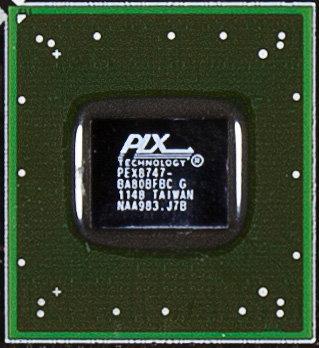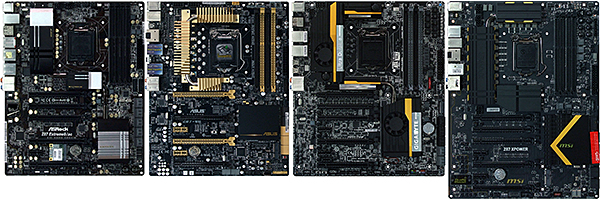Four Z87 Express Motherboards For Three- And Four-Way SLI
Formerly a very exclusive component, the PCI Express switch that makes Intel’s LGA 1150-based platforms three- and four-way SLI-capable is now available across a range of high-end motherboards. Today we compare four premium enthusiast-oriented models.
Making Z87 Express Three-Way SLI-Capable
Why you can trust Tom's Hardware
We've seen incremental updates to Intel's processor architectures yield small performance benefits in games for the past several generations. However, a great many enthusiasts dislike some of the platform restrictions Intel put in place. For instance, CPUs built around the LGA 1156, 1155, and 1150 interfaces have integrated PCI Express controllers limited to 16 lanes of connectivity. Of course, that's a great way to help minimize latency. But Nvidia's official stance is that those available lanes support a maximum of two GeForce graphics cards. A third would force you to split into x8, x4, and x4 links. So what's a fan of three-way SLI supposed to do?
Stepping up to LGA 2011 gives you access to 40 lanes of third-gen PCIe, but you also have to take an architectural step backwards. Up until Intel launched its Ivy Bridge-E-based chips, you actually had to take two steps back. And beyond higher-priced components, you're talking about using more power and generating more heat, too.
But there's a solution, which isn't particularly new. Used to enable AMD's and Nvidia's fastest dual-GPU graphics cards, PLX Technology's ExpressLane PEX8747 48-lane PCIe 3.0 switch acts a lot like a repeater hub, broadcasting the same data to multiple devices, turning 16 lanes on one end of the switch into 32 lanes on the other, without dividing bandwidth (since CrossFire and SLI require all GPUs to receive identical data).
The usual marketing caveats apply, beginning with PLX calling this a 48-lane switch when, again, it takes 16 lanes on one end and facilitates 32 on the other. Moreover, three- and four-card configurations do cause bandwidth division, cutting dual 16-lane links into eight-lane interfaces. And finally, there’s the slight latency penalty of adding another component, though that seems minor considering both graphics vendors drop the switch onto their GeForce GTX 690 and Radeon HD 7990 without negative consequence.
| LGA 1150 ATX Motherboard Features | ||||
|---|---|---|---|---|
| Row 0 - Cell 0 | ASRock Z87 Extreme9/ac | Asus Z87-WS | Gigabyte Z87X-UD7 TH | MSI Z87 XPower |
| PCB Revision | 1.02 | 1.04 | 2.0 | 1.1 |
| Chipset | Intel Z87 Express | Intel Z87 Express | Intel Z87 Express | Intel Z87 Express |
| Voltage Regulator | 12 Phases | Eight Phases | 16 Phases | 32 Phases |
| BIOS | P2.00 (11/27/2013) | 1504 (10/04/2013) | F2 (11/08/2013) | 1.4 (11/27/2013) |
| 100.0 MHz BCLK | 100.00 (+0.00%) | 99.94 (-0.06%) | 99.77 (-0.23%) | 100.01 (+0.01%) |
| I/O Panel Connectors | ||||
| P/S 2 | 1 | 1 | 1 | 1 |
| USB 3.0 | 6 | 4 | 6 | 8 |
| USB 2.0 | 2 | 4 | None | 2 |
| Network | 2 | 2 | 2 | 1 |
| CLR_CMOS Button | 1 | None | None | 1 |
| Digital Audio Out | Optical | Optical | Optical | Optical |
| Digital Audio In | None | None | None | None |
| Analog Audio | 5 | 6 | 5 | 6 |
| Video Out | HDMI, Dual Thunderbolt | Mini DisplayPort 1.2, HDMI, Full DisplayPort | Dual HDMI, Dual Thunderbolt (Three displays) | Dual HDMI, DisplayPort |
| Other Devices | eSATA, DisplayPort In (for pass-through) | Dual eSATA, USB BIOS Flashback | None | Wi-Fi/Bluetooth Module |
| Internal Interfaces | ||||
| PCIe 3.0 x16 | 4 (x16/x0/x16/x0 or x8/x8/x8/x8) | 4 (x16/x0/x16/x0 or x8/x8/x8/x8) | 4 (x16/x0/x16/x0 or x8/x8/x8/x8) | 4 (x16/x0/x16/x0 or x8/x8/x8/x8) |
| PCIe 2.0 x16 | None | None | None | None |
| PCIe 2.0 x1 | 1-standard, 1-Mini (filled) | 2 | 2 | 2 |
| USB 3.0 | 2 (4-ports) | 1 (2-ports) | 2 (4-ports) | 2 (4-ports) |
| USB 2.0 | 3 (6-ports) | 2 (4-ports) | 2 (4-ports) | 2 (4-ports) |
| SATA 6.0 Gb/s | 10 (shared with eSATA) | 10 (shared with mSATA) | 10 | 10 (shared with mSATA) |
| 4-Pin Fan | 2 | 6 | 7 | 7 |
| 3-Pin Fan | 4 | None | 2 | None |
| FP-Audio | 1 | 1 | 1 | 1 |
| S/PDIF I/O | None | Output Only | Both | None |
| Internal Buttons | Power, Reset | MemOK, CLR_CMOS, DirectKey, Power, Reset | Ratio +/-, BCLK +/-, CLK increments, OC Turbo, OC Tag, OC IGN, Power, Reset, CLR_CMOS | Ratio +/-, BCLK +/-, Discharge, OC Genie, Go2BIOS, Power, Reset, CLR_CMOS |
| Internal Switch | Dual BIOS | EPU, TPU | OC Trigger, BIOS Mode, BIOS ROM, Slot Disable | OC mode, CLK increments, BIOS ROM, Slot Disable |
| Diagnostics Panel | Numeric | Dual Numeric | Numeric | Numeric |
| Other Devices | Serial COM port, USB Port | Serial COM port, USB Port, IEEE1394 | Serial COM port | Voltage check pins |
| Mass Storage Controllers | ||||
| Chipset SATA | 6 x SATA 6Gb/s (Total) Shared w/eSATA, mSATA | 6 x SATA 6Gb/s (Total) Shared with 1x mSATA | 6 x SATA 6Gb/s | 6 x SATA 6Gb/s |
| Chipset RAID Modes | 0, 1, 5, 10 | 0, 1, 5, 10 | 0, 1, 5, 10 | 0, 1, 5, 10 |
| Add-In SATA | 2 x ASM1061 PCIe 4 x SATA 6Gb/s, 1 x eSATA (shared) | 88SE9230 PCIe x2 4 x SATA 6Gb/s ASM1061 PCIe 2 x eSATA | 88SE9230 PCIe x2 4 x SATA 6Gb/s | 2 x ASM1061 PCIe 4 x SATA 6Gb/s, |
| USB 3.0 | 2 x ASM1074 Hub 8 x USB 3.0 Ports | ASM1074 Hub 4 x USB 3.0 Ports | 2 x PD720210 Hub(8-ports) | 2 x ASM1074 Hub 8 x USB 3.0 Ports |
| Networking | ||||
| Primary LAN | WGI217V PHY | WGI210AT PCIe | WGI217V PHY | Killer E2205 PCIe |
| Secondary LAN | WGI211AT PCIe | WGI210AT PCIe | WGI210AT PCIe | None |
| Wi-Fi | BCM4352 PCIe 802.11ac Dual-Band (2x2; 867 Mb/s) | None | Intel 7260 PCIe 802.11ac Dual-Band (2x2; 867 Mb/s) | Intel 2230 PCIe 802.11n Single-Band (2x2; 300 Mb/s) |
| Bluetooth | By 802.11ac Combo | None | By 802.11ac Combo | By 802.11n Combo |
| Audio | ||||
| HD Audio Codec | ALC1150 | ALC1150 | ALC898 | ALC1150 |
| DDL/DTS Connect | DTS Connect | DTS Connect | None | None |
| Warranty | Three Years | Three Years | Three Years | Three Years |
Three of the above boards have a fifth PCIe x16 slot, but they're all limited to four x16 cards. Located between the first and third x16 slots, the fifth x16 interface is wired directly to the CPU, bypassing the PEX8747 bridge. Anyone not interested in three- or four-way SLI would be better off buying a less expensive motherboard without the PLX switch, so the folks in the market for these platforms can just go ahead pretending the extra slot isn't even there.
Two of the boards in today’s test offer Intel’s Thunderbolt technology, which pairs DisplayPort graphics and PCIe in a single serial signal. Compatible devices eat into both cable bandwidth and the Z87 Express chipset’s eight PCIe 2.0 lanes however, requiring ASRock and Gigabyte to add yet another PLX bridge, the four-lane PEX8605. Adding storage devices to the mini-DisplayPort connectors forces displays down from 4K-capable to a maximum of 2560x1600, while on-board devices and PCIe x1 slots are similarly made to share bandwidth over the PEX8605.
Current page: Making Z87 Express Three-Way SLI-Capable
Next Page ASRock Z87 Extreme9/acGet Tom's Hardware's best news and in-depth reviews, straight to your inbox.
-
iam2thecrowe Am i missing something here? I dont see the point of reviewing 3 and 4 way sli boards and not testing 3 and 4 way sli. Seems rather pointless since any average motherboard will perform well in adobe, productivity etc benches dependent on the cpu....Reply -
Crashman This was really just about finding any board that supports Nvidia's requirements about how that third card is connected. We found some, I overclocked them, now I have enough data to pick a board for the System Builder Marathon. But that only explains why overclocking took priority!Reply
After spending two days per board on a "one week" article, I couldn't add more tests. The general benchmark set looks for unintended overclocking/underclocking, power and memory bandwidth issues, so you can see the performance difference attributable to each board's CPU and DRAM configuration differences. It runs from a .bat file, so it didn't add significantly to the article's completion time.
The PLX bridge that these all share represents the "great equalizer" when it comes to CrossFire and SLI configuration, so that portion of all three boards should be identical. I understand that things that should be the same in theory are occasionally different in practice. My apologies for not having the extra 1-day per board for additional tests. -
iam2thecrowe Reply12341788 said:They all use the same PLX bridge, so you would have seen a whole bunch of identical gaming results. The general benchmark set looks for unintended overclocking/underlocking, power and memory bandwidth issues, so you can see the actual performance difference. And there's still an overclocking section.
These boards had to be tested for general performance and stability like any other boards. The PLX controller is the equalizer when it comes to games.
I think testing 3/4 way sli would still be valid, as it doesn't always work properly, in the past there have been compatibility problems with certain gpu's/boards/firmware/controllers and certain benchmarks completely failed. -
Kraszmyl "internally-mounted external USB 2.0 port for ReadyBoost fanatics" on the asus z87.Reply
Those have nothing to do with readyboost. The internal usb ports are very common on workstations and you put CAD dongles and equivalent items in them so that you can lock them inside the case and don't have to worry about some one stealing them from the outside or them taking up an outside usb port. -
Memnarchon I would love to see Asus Maximus VI Extreme, but it seems ASUS didn't want to give a 2nd board and prefered the Z87 WS....Reply -
Traciatim where are the sli/crossfire benchmarks and comparisons with traditional non-switched setups?Reply
Hey guys, we have these awesome new setups for supreme graphics pumping power! Watch it zip files like every other board! -
duramax08 Why are they still making motherboards with PS/2 connections? Its time to move on, replace those baby's with some USB 3.0!Reply


